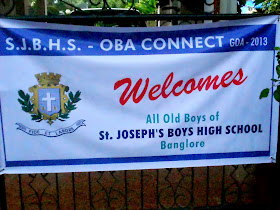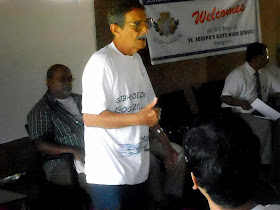Historians have concluded that Arabs, Chinese and Jews settled in the Fort Kochi area back in the 1400s. After that it seemed to be a free flow of traffic, with the Portugese, Dutch and British adding to the colour one by one. For the settlers, the explorations were long, hazardous journeys by ship. I was on a teaching trip at a Management institution near Kochi. The view outside the window was rather pleasant and distracting.
All I had to do on a day without any scheduled classes was to hop into an auto-rickshaw which crossed several bridges and even went on a ride on a ferry. The ferries carry auto-rickshaws, cars, cycles, scooters, motor-cycles and pedestrians. Local folks and tourists use the ferry every day, like the family with two little kids who seemed to be slightly self-conscious dressed in their holiday best.
Fishermen at the Chinese Fishing Nets work in unison to ease the nets into the water, and to pull them out after a while.
A simple counterbalancing mechanism built up of stones help the fishermen raise and lower the nets into the water.
Down she goes...
The group gives me a little demo in return for a small consideration. It is the lean season, the waters are choppy and the catch is limited. Any support is highly appreciated. The fishermen pull out the net, singing their song.
All that appears in the net is a little sword-fish type of a fish. I guess the nets need to stay in far longer.
The streets around the Chinese Fishing Nets are quiet and leafy, ideal for strolling around by the Fishing Nets and the fish stalls.
Several Fish stalls dot the area. You are allowed to take your pick of fish.
Restaurants wait for you to bring over your 'catch of the day'.
The fish is cooked right there while you wait.
The result is a plate of freshly grilled Fish.
Tourist buses park under the trees, many having arrived from far away cities. Looks like Audi manufactures buses these days!
Two visitors take a quick smoke break. Purple umbrellas. Purple trousers. Red umbrellas. Red trousers. Matching-matching!
Not too far from the Chinese Fishing Nets is a historical monument of high importance, the St Francis Church.
The interiors of the Church are cool, and services are held regularly.
For whatever reason, Vasco da Gama's body was removed after 14 years, and transferred to Portugal. Reminded me of the story of St Francis Xavier who died in China, was buried there, after which the incorrupt body was transferred to Portugese Malacca, and was finally brought to Goa.
The Church used to be the home of soldiers' graves in the past. The tombstones of the graves have been removed and have been placed along the walls inside the Church.
The area near Fort Kochi now known as Mattanchery houses several buildings from the past, the most well known being the Mattanchery Palace. The Kochi Royal Family used to live here during the 1500s, they sought support from the Portugese against the attackers from the Malabar Kingdom, and offered them trading rights. Subsequently the Dutch ran over the area in the 1600s.
The Palace has lovely murals depicting the story of the Ramayana painted on the walls. Weapons, furniture and other belongings of the Rajas are preserved inside the Palace. The outside of the Palace, however, is extremely shabby.
The entry fee is a princely Rs 5. Well, what else would you expect the state of preservation to be like?
Not too far from St Francis Church and the Mattanchery Palace is the Dutch Cemetery, a reminder of the melting pot that Fort Kochi used to be at one time in the 1500s and the 1600s.
The Police Museum is a remarkably well preserved museum. It houses weapons, paintings and photographs showing the evolution of the Police forces of the kingdoms of Kerala over centuries.
The exterior of the building and the gardens are preserved in an excellent state, perhaps the best I have seen of any historical, tourism related structure in India. The Police Museum also houses a Police Station inside the building. Probably the most well protected museum in India.
The streets around Fort Kochi are maintained in amazingly good condition. Travellers' most common requirements are likely to be available: Cycles, Scooters, Guest houses, Food, Mobile communications outlets, Laundry and Travel agents.
The streets in the Jew Town are a pleasure to wander in. Several spice trade related buildings have been preserved.
The well known Synagogue was constructed in the 1660s, while the clock tower was added in 1760.
It is a fully functional synagogue even today. It turned out to be closed that day!
The Synagogue is closed on Fridays, Saturdays and official holidays.
It appears as if the street leading down to the Synagogue may have to be renamed 'Kashmir' street shortly, if the monopoly of Kashmiri traders and stores is any indication. The Kashmiris seem to be the latest settlers in Fort Kochi during the 21st century.
Looking back towards the land as the ferry crosses the waterway back on its way towards Ernakulam, it appears like the past is quietly receding into the distance.
For sure, Fort Kochi represents the colourful, quiet Indian melting pot over the centuries.
-=-=-=-=







































































